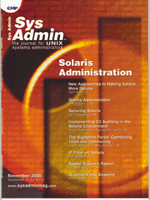
Questions and Answers
Jim McKinstry
http://home.earthlink.net/~bhami/rosetta.html
This site lists many common tasks/commands and how to perform them on many different UNIX systems. It's a pretty handy site to have. See Table 1 for an example.
sd2 at esp0: target 2 lun 0 sd2 is /<stuff deleted>/sd@2,0Let's break this down:
esp0 is the interface controller number (c0). Put all this together and you get c0t2d0.
ufsdump 0uf /dev/rmt/0 /test Unmount the filesystem: umount /testMount the new file system on the mount point and change directory to it:
mount /dev/dsk/c2t2d0s4 /test; cd /testNow restore the contents to the new file system:
Ufsrestore rvf /dev/rmt/0Make sure that you change the mount point in the /etc/vfstab so that the file system is mounted correctly at the next boot. Moving the file system in this manner is really nice because, if something goes wrong, you always have the original data in the original file system and on tape.
v1:234:respawn:/usr/lib/saf/ttymon \ -g -h -p "'uname -n' VT01 login: " \ -T AT386 -d /dev/vt01 -l console v2:234:respawn:/usr/lib/saf/ttymon \ -g -h -p "'uname -n' VT02 login: " \ -T AT386 -d /dev/vt02 -l consoleYou can have up to seven virtual terminals (in Solaris 2.6). Add one line per terminal. If the device files do not exist, create them with the following command (one per virtual terminal):
mknod vt01 c 100 1 mknod vt02 c 100 2Now restart the init process (ps -ef | grep init kill -HUP <pid of init>, or init q, or just reboot). To switch between the virtual terminals, use the following:
<Alt><SysReq><F1-F7> \ -- switch to virtual terminal 1 through 7. <Alt><SysReq><n> \ -- switch to the next virtual terminal. <Alt><SysReq> -- switch to \ the previous virtual terminal. <Alt><SysReq><h> \ -- switch to the console.You could also add Screen to your system. You can download Screen from:
http://www.gnu.org/software/screen/According to the GNU Web site: Screen is a full-screen window manager that multiplexes a physical terminal between several processes, typically interactive shells. Each virtual terminal provides the functions of the DEC VT100 terminal and, in addition, several control functions from the ANSI X3.64 (ISO 6429) and ISO 2022 standards (e.g., insert/delete line and support for multiple character sets). There is a scrollback history buffer for each virtual terminal and a copy-and-paste mechanism that allows the user to move text regions between windows. When screen is called, it creates a single window with a shell in it (or the specified command) and then gets out of your way so that you can use the program as you normally would. Then, at any time, you can create new (full-screen) windows with other programs in them (including more shells), kill the current window, view a list of the active windows, turn output logging on and off, copy text between windows, view the scrollback history, switch between windows, etc. All windows run their programs completely independent of each other. Programs continue to run when their window is currently not visible and even when the whole screen session is detached from the users terminal.
hostname.le0 hostname.le1 hostname.le2 hostname.le3Rename each of these files to what they should be. For example, if the Solaris 2.5.1 le0 interface is now the Solaris 2.6 le2 interface, then rename the hostname.le0 file to hostname.le2. Do this for each interface. When you reboot, your network should be working again.
http://www.sun.com/products/ \ staroffice/products/and try it out. You can run it on your current system and if it all checks out for you, upgrade your operating system to Solaris x86 and keep on using it. StarOffice consists of:
StarOffice Writer: Professional Document Creation and Publishing As of the 5.2 release, the following filters are available:
Microsoft Word 5.0, 6.0, 95, 97, 2000
About the Author
Jim McKinstry is a Senior Sales Engineer for MTI Technology Corporation (www.mti.com). MTI is a leading international provider of data storage management products and services. He can be reached at: jrmckins@yahoo.com.
|